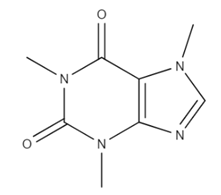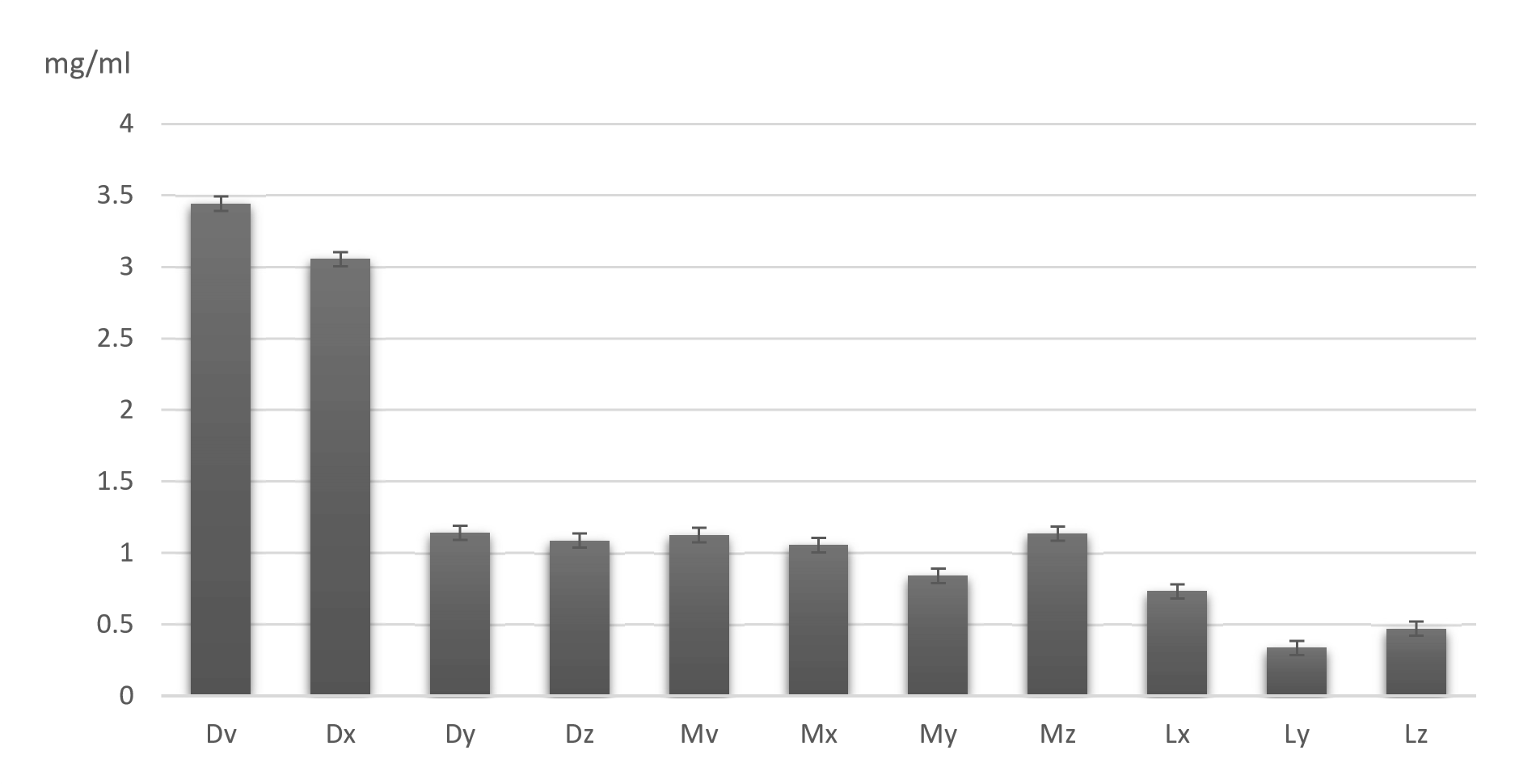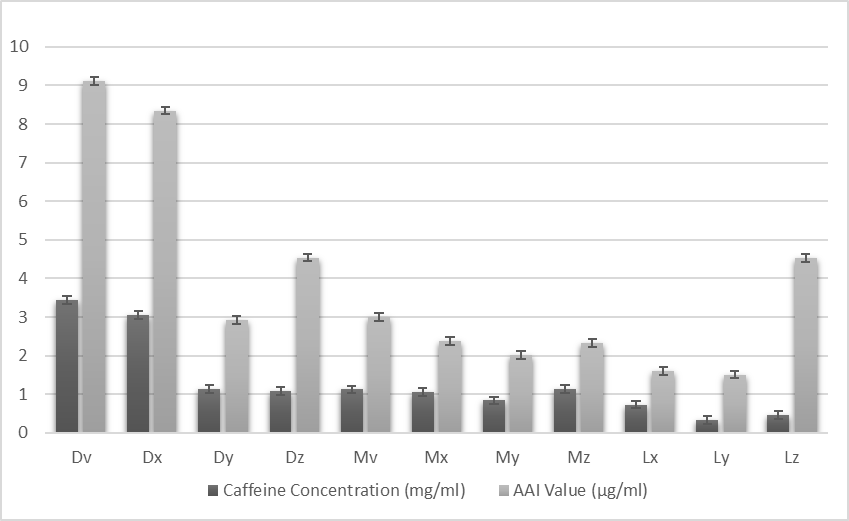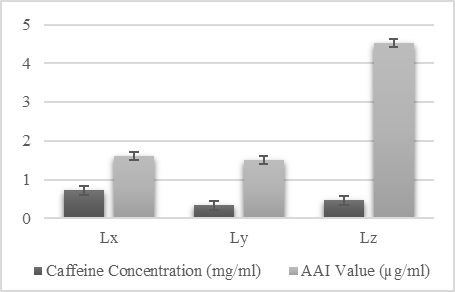Comparison of caffeine content in different types of coffee in Saudi Arabia
Abstract
Due to its stimulating qualities and advantageous effects on the human body, coffee is important to both consumers and researchers. The roasting procedure and the method used to prepare the brew are two of the most crucial factors affecting coffee infusion's properties Caffeine (1,3,7-Trimethylpurine-2,6-dione) is an alkaloid found in coffee beans. The global demand and commercial advertising have contributed to increasing the average coffee consumption to an average of three cups per day. This study aims to compare the caffeine content and antioxidant activity in different types of coffee consumed in Saudi Arabia. Coffee samples (11 kinds) with different roasting degrees were randomly selected from the most popular coffee brands in the Saudi market. Caffeine content was determined using an HPLC system. In addition, the free radical DPPH (2,2-diphenyl-1-picrylhydrazyl) scavenging activity assay was used to measure the antioxidant activity of each coffee sample. The results showed an inverse correlation between the roast degree and the antioxidant activity and a direct relationship between the roast degree and caffeine content. Lastly, the roast degree correlates inversely with pH. Based on the results of this study, it was concluded that drinking three cups of coffee from the darker roasts is considered above the RDA. Contrarily this result suggests that dark roast coffee is safer.
Keywords: Coffee, Caffeine, DPPH, HPLC, AAI, Antioxidant
Introduction
Caffeine (1,3,7-Trimethylpurine-2,6-dione) is an alkaloid of the methylxanthine found in the leaves, seeds, or fruits of over 63 plant species in different countries and the most well-known biologically active compounds in coffee beans [1] (Figure 1). Alkaloids are low molecular weight compounds produced mainly by animals and plants for protection against predators [2]. Caffeine was discovered in coffee arabica back in the 1820s, it is synthesized from a purine nucleoside called Xanthosine, making caffeine a part of the purine alkaloid family which are secondary metabolites of purine nucleotides [3]. However, coffee was discovered and used many centuries before caffeine was discovered by Friedlieb Ferdinand Runge and his colleagues [4]. Yemen was the first country to cultivate coffee in the mid-fifteenth century. Coffee was traded throughout the middle east and it was restricted to the surrounding Arab nations for nearly 50 years. Coffee was then introduced to Turkey and Europe by the sixteenth century [5]. It is found that a moderate daily caffeine intake of up to 400 mg per day is not related to harmful effects in the healthy adult population [6]. Caffeine is a drug while low to moderate doses are generally safe, high consumption of caffeine can cause adverse effects on the consumer’s health [7]. Caffeine can increase anxiety, and disrupt sleep patterns, and the coffee itself can affect the stomach if the consumer has problems with acid reflux or heartburn [8, 9]. However, coffee in the proper quantity has benefits besides increased wakefulness. It may favorably improve health, consumers are less likely to develop heart failure, and it also has a favorable effect on liver function. Metabolic studies indicate that caffeine may improve energy balance by diminishing appetite, enhancing basal metabolic rate, and promoting food-induced thermogenesis [10]. Consuming coffee and caffeine has been additionally associated with reduced risks of depression [11]. Additionally, coffee trials disapprove that caffeinated coffees have an impact on blood pressure [12]. The beneficial health effects of coffee are usually attributed to its high antioxidant activity and hence, its ability to inhibit the process of oxidation. Antioxidants are synthetic or natural substances that have a crucial role in scavenging reactive oxygen species (ROS) and reactive nitrogen species (RNS) [13]. Also, antioxidants have a role in cancer prevention, they can prevent or postpone certain types of cell damage by having inhibitory effects on cell transduction and cell proliferation pathways [14]. The antioxidant activity of coffee is related to its content of chlorogenic, ferulic, caffeic, and n-coumaric acids [15]. Due to its stimulating property and the aforementioned health benefits, coffee is of importance to both consumers and researchers. The roasting procedure and the method used to prepare the brew are two of the most crucial factors that affect the properties of coffee infusions. This study aimed to compare the caffeine content and antioxidant activity in different types of coffee in Saudi Arabia.
|
|
|
Figure 1. Caffeine structure |
Materials and Methods
Caffeine detection using HPLC
A chromatographic system with an analytical HPLC unit model 1100 (Agilent Technologies, CA, USA) equipped with a binary pump, an automated sample injector, and a DAD lamp was used to measure the amount of caffeine (Agilent Technologies, CA, USA). Samples (Table 1) were injected into a C18 column microliter (100 mm 2.1 mm I.D.; 2.6 m) from Phenomenex (Torrance, CA, USA) that was kept at 25 °C in increments of 50. At a flow rate of 0.8 mL min1, the mobile phase used in the analysis was 8 mM formic acid in water (pH 2.8) (solvent A) and acetonitrile (solvent B). Elution began at 10% A and was maintained for 5 minutes; the percentage of solvent A was increased to 20% in 10 minutes and maintained for 10 minutes, then to 50% in 20 minutes and maintained for 3 minutes, and finally to 80% in 15 minutes. A diode array detector (DAD) was used to detect caffeine, and chromatograms were measured at 276 nm [16].
Coffee brews (CB) preparation and pH measurement
Coffee grounds (5 g) and boiling water were used to make coffee brews (CB) using the solid-liquid extraction method (100 mL). CB was kept in a water bath for five minutes (GFL-10WB-3) (95 °C) then cooled to 20 °C and finally filtered through filter paper, samples were poured into centrifuge tubes for centrifugation, then all tubes were inserted into the centrifuge (HERMLE Z 200 A) at 4500 rpm for 5 minutes. Finally, samples were filtered through filter papers [17].
The free radical DPPH· scavenging activity assay (DPPH)
Briefly, the prepared sample was mixed withDPPH methanolic solution (3:1). Absorption was measured at 517 nm using a spectrophotometer (APEL PD-303) after 30 minutes of incubation in the dark [17]. The results were expressed as an antioxidant activity index (AAI) using the following formula:
|
|
(1) |
where IC50 is a concentration providing 50 % inhibition of free radical DPPH [17].
|
Table 1. Samples collected from the Saudi Market |
|
|
Dv |
American dark-medium roast (instant) |
|
Dx |
American dark roast (instant) |
|
Dy |
American dark roast |
|
Dz |
American dark roast |
|
Mv |
American medium roast |
|
Mx |
American medium roast |
|
My |
American medium roast |
|
Mz |
American medium roast |
|
Lx |
Arabic light roast |
|
Ly |
Arabic light roast |
|
Lz |
Arabic light roast (instant) |
Results and Discussion
Caffeine content determination in Arabica coffee samples using HPLC
The results of caffeine content displayed in Figure 2 show that Brazilian coffee samples revealed the highest caffeine concentration (3.05 – 3.44 mg/ml), it is important to mention that the Brazilian samples Dv and Dx are almost three times higher in caffeine concentration comparing to all coffee samples (Figure 3). Moreover, it showed higher caffeine content even when compared with the dark roasted samples alone. It was found that this high caffeine content in the two samples was because they were instant coffee samples the way instant coffee packets are manufactured explains the amount of caffeine concentration in these two samples. Colombian coffee samples showed lower caffeine concentration (1.12 – 1.14 mg/ml). Followed by the Ethiopian coffee samples with caffeine concentrations ranging from 0.47 to 1.08 mg/ml. Lastly, Saudi Arabian coffee samples showed the lowest caffeine concentration (0.33 – 1.05 mg/ml). The use of HPLC for caffeine determination represented a significant qualitative advance in terms of the characteristics of precision, accuracy, and speed [18]. When comparing caffeine concentration and the degree of roast, a direct proportion is displayed, the higher the roast, the higher the caffeine concentration. However, researchers reported that there are no significant differences in caffeine concentration in different roasts [19]. Moreover, dePaula et al. agreed and concluded that Caffeine content does not change significantly during coffee roasting due to its thermal stability. However, minor losses may occur due to sublimation.
Caffeine content may increase due to the loss of thermolabile compounds in terms of percent composition [18]. The caffeine concentration can be measured by calculating how much mg of caffeine is in each cup, the average cup size is nearly 200ml. Sample Dz’s caffeine concentration was 1.08mg/ml, 200ml of sample Dz is 216mg of caffeine, and so on. It is important to mention the RDA of caffeine, according to the Food and Drug Administration, 400mg of caffeine is the RDA for the average adult, and 200mg for pregnant women. For the dark-roasted coffee grounds a cup of instant coffee would contain 610-688mg of caffeine, thus 3 cups of instant dark-roasted coffee can contain up to 2064mg of caffeine. However, a cup of dark coffee grounds would contain 216-228mg of caffeine, thus 3 cups of dark roasted coffee grounds can contain up to 864mg of caffeine. For the medium roasted coffee grounds, a cup of coffee would contain 166-250mg of caffeine. Thus 3 cups of medium coffee can contain up to 750mg of caffeine. For the lightly roasted coffee grounds a cup of coffee would contain 66-146mg of caffeine, thus 3 cups of light coffee can contain up to 438mg of caffeine. It can be concluded that 3 cups which equals 600ml of coffee is considered a high dosage of caffeine intake in all roasts. According to researchs elevation in caffeine, consumption can cause many adverse side effects on the consumer’s health, such as anxiety, disturbed sleeping patterns, headaches, and adverse effects in the stomach for patients with acid reflux [8, 9].
|
|
|
Figure 2. Caffeine concentration in Arabica coffee samples. Data were presented as the mean of 3 replicas ± StDev. B, comparison of caffeine concentration and AAI value (DPPH concentration) in Arabica coffee samples. Data are presented as the mean of 3 replicas ± StDev. |
|
|
|
Figure 3. Caffeine concentration in Arabica coffee samples. Data are presented as the mean of 3 replicas ± StDev. B, comparison of Caffeine concentration and AAI value (DPPH concentration) in Arabica coffee samples. Data are presented as the mean of 3 replicas ± StDev. |
Assessment of antioxidant activity in Arabica coffee samples using DPPH concentration
A common method used in assays to determine the antioxidant capacity of biological materials is the DPPH free radical-scavenging activity, and this approach has been continuously improved up to the present [17]. From the AAI results that are shown in Figure 4, high AAI values were for the dark roasted coffee samples. Contrarily lightly roasted samples, the preferred roast in making Saudi Arabic Coffee, had the lowest AAI value. However, sample Lz (Figure 5) showed a slightly higher AAI value compared to other light-roasted samples, it is speculated that this might be due to the impurity of the coffee sample, it had additives like cloves and cardamom. The AAI represents the DPPH concentration, the higher the AAI the higher the DPPH concentration, AAI, and antioxidant activity have an inverse relationship when AAI is high the sample has low antioxidant activity. On the other hand, Brazilian coffee samples were nearly three times lower in antioxidant activity than Colombian and Saudi Arabian coffee samples. Our results highlight that roasting increased free radical scavenging activity. A similar conclusion was reached by researchers [20]. Also, in another research reported that coffee beans lose approximately 40–80% of antioxidant activity after roasting [21]. In contrast to that study, Jung et al. reported that the DPPH radical scavenging activity decreased as the roasting proceeded [22], which was opposite to the results of this study. However, It has been noted that the reduct one moiety found in Maillard reaction products possesses both reducing and chelating properties. Different reduce ones made during the Maillard reaction process may help explain why heating increases its capacity to scavenge DPPH radicals [23].
The correlation coefficient between caffeine concentration in Arabica coffee samples, DPPH, and pH
These results were proved by studying the correlation coefficient between caffeine concentration in Arabica coffee samples, DPPH, and pH as shown in Table 2. The results in Table 2 showed that there are positive correlations between AAI antioxidant and Caffeine concentration. Despite lower levels of natural antioxidants, coffee's antioxidant activity increased with roasting. In agreement with our results, a previous study confirmed this correlation [17]. While there was a negative correlation between the pH with caffeine concentration and AAI, the difference in the acidity of brew coffee is likely not due to caffeine content considering that most acids in coffee are highly soluble and extract quickly [24].
|
Table 2. The correlation coefficient between caffeine concentration in Arabica coffee samples, DPPH, and pH. |
|||
|
Caff |
AAI |
pH |
|
|
Caff |
1 |
||
|
AAI |
0.905085 |
1 |
|
|
pH |
-0.60131 |
-0.48741 |
1 |
|
|
|
Figure 4. AAI value (DPPH concentration) in Arabica coffee samples. Data are presented as the mean of 3 replicas ± StDev. |
|
|
|
Figure 5. Caffeine concentration and AAI value (DPPH concentration) in Arabica coffee light roasted samples. Data are presented as the mean of 3 replicas ± StDev. |
Qualitative determination of pH in Arabica coffee samples with different roasting degrees
The pH results of dark roasts showed lower values (4.83 - 4.98) compared to medium (4.85 - 5.19) and light (5.40 - 5.78) roasts (Table 3). A similar conclusion was reached by researchers [17]. This means that the dark-roasted coffee samples were more acidic than those that were medium and lightly roasted. So, it can be concluded that pH and the roast degree have an inverse relationship, the higher the roast, the lower the pH.
|
Table 3. pH in Arabica coffee samples. Data are presented as means of 3 replicas. |
|
|
Sample |
pH |
|
Dv |
4.91 |
|
Dx |
4.83 |
|
Dy |
4.98 |
|
Dz |
5.14 |
|
Mv |
4.85 |
|
Mx |
4.90 |
|
My |
5.19 |
|
Mz |
5.03 |
|
Lx |
5.78 |
|
Ly |
5.55 |
|
Lz |
5.40 |
Conclusion
Due to the increased demand and commercial advertising, the average consumption of an adult was raised to 3 cups of coffee daily. Based on the analysis that was performed in this study, the caffeine concentration can be measured by calculating how much mg of caffeine is in each cup, the average cup size is nearly 200 ml. Dark instant coffee packets showed extreme caffeine content that can cause health complications if consumed at this rate daily. Lightly roasted coffee which is the preferred roast in making Saudi-style coffee showed the least caffeine concentration, Saudi style coffees are made in pots, and drinking up to 1L of Saudi coffee is considered safe. However, it is not recommended to exceed that amount. When it comes to antioxidant activity, it can be concluded that the light-roasted coffee samples showed the highest antioxidant activity, contrarily the instant dark and dark-roasted samples showed the least. Lastly, the pH of dark instant coffee and high roasts were more acidic than those of lighter roasts, the high acidity in the darker roasts can cause various health complications like heartburn, gastric ulcers, and acid reflux if consumed at that rate daily. Based on the findings of this study, it is recommended to lessen the amounts of coffee ingested per day or change the preferred drinking roasts into lighter roasts. Also, these findings suggest that to maintain the highest levels of antioxidant activity possible, the roasting time should be optimized. However, a statistically significant result was observed, so these findings are informative and may reveal which roast of coffee is the best to consume to lower the potential risk of free radicals.
Acknowledgments: This work was funded by Mawakeb Alajer Association, Jeddah, Saudi Arabia through the Science Research and Innovation Unit at the Faculty of Science, King Abdulaziz University, Jeddah, Saudi Arabia under research number (scigriu41/06). Therefore, the authors gratefully acknowledge technical, and financial support from Mawakeb Alajer Association and Science Research and Innovation Unit at King Abdulaziz University, Jeddah, Saudi Arabia.
Conflict of interest: None
Financial support: This work was funded by Mawakeb Alajer Association, Jeddah, Saudi Arabia through the Science Research and Innovation Unit at the Faculty of Science, King Abdulaziz University, Jeddah, Saudi Arabia under research number (scigriu41/06).
Ethics statement: None
References
- Elmanfe GM, Khalifa HO, Khreit O, Abduljalil O. Determination of caffeine and some other drugs in cappuccino, nescafe, cacao, coffee samples collected from some libyan markets using high performance liquid chromatography (RP-HPLC). J Pure Appl Sci. 2021;20(4):149-55.
- Verma R, Patel M, Shikha D, Mishra S. Assessment of food safety aspects and socioeconomic status among street food vendors in Lucknow city. J Agric Food Res. 2023;11:100469.
- Ashihara H, Crozier A. Caffeine: A well known but little mentioned compound in plant science. Trends Plant Sci. 2001;6(9):407-13.
- Sinha D, Odoh UE, Ganguly S, Muhammad M, Chatterjee M, Chikeokwu I, et al. Phytochemistry, history, and progress in drug discovery. InPhytochemistry, Computational Tools and Databases in Drug Discovery 2023 Jan 1 (pp. 1-26). Elsevier.
- Oliveira H, Pérez-Gregorio R, Fernandes I, Soares S, Freitas V, Dias R. New trends from plant secondary metabolism in the pharmaceutical industry. InNatural Secondary Metabolites: From Nature, Through Science, to Industry 2023 Feb 22 (pp. 779-822). Cham: Springer International Publishing.
- Przeor M, Beszterda M. Coffee methylxanthines and human health effects. InCoffee Science 2023 (pp. 251-263). CRC Press.
- Solanki N, Patel Y. Drug utilization pattern and drug interaction study of antibiotics prescribed to orthopedic patients in private hospital. Arch Pharm Pract. 2019;10(4):114-7.
- Abdulfattah AA, Jawkhab HA, Alhazmi AA, Alfaifi NA, Sultan MA, Alnami RA, et al. The association of smoking and coffee consumption with occurrence of upper gastrointestinal symptoms in patients with active helicobacter pylori infection in Jazan city: A cross-sectional study. Cureus. 2023;15(1):e33574.
- Smith A. Effects of caffeine on human behavior. Food Chem Toxicol. 2002;40(9):1243-55.
- van Dam RM, Hu FB, Willett WC. Coffee, caffeine, and health. N Engl J Med. 2020 23;383(4):369-78.
- Lee EK, Poon P, Yu CP, Lee VW, Chung VC, Wong SY. Controlled‐release oral melatonin supplementation for hypertension and nocturnal hypertension: A systematic review and meta‐analysis. J Clin Hypertens. 2022;24(5):529-35.
- Kang D, Kim Y, Je Y. Non-alcoholic beverage consumption and risk of depression: Epidemiological evidence from observational studies. Eur J Clin Nutr. 2018;72(11):1506-16.
- Gebeyehu BT, Bikila SL. Determination of caffeine content and antioxidant activity of coffee. Am J Appl Chem. 2015;3(2):69-76.
- Camouse MM, Hanneman KK, Conrad EP, Baron ED. Protective effects of tea polyphenols and caffeine. Expert Rev Anticancer Ther. 2005;5(6):1061-8.
- Yashin A, Yashin Y, Wang JY, Nemzer B. Antioxidant and antiradical activity of coffee. Antioxidants. 2013;2(4):230-45.
- Lin YH, Huang HW, Wang CY. Effects of high pressure-assisted extraction on yield, antioxidant, antimicrobial, and anti-diabetic properties of chlorogenic acid and caffeine extracted from green coffee beans. Food Bioproc Tech. 2022;15(7):1529-38.
- Dybkowska E, Sadowska A, Rakowska R, Debowska M, Swiderski F, Swiader K. Assessing polyphenols content and antioxidant activity in coffee beans according to origin and the degree of roasting. Rocz Państw Zakł Hig. 2017;68(4):347-53.
- dePaula J, Farah A. Caffeine consumption through coffee: Content in the beverage, metabolism, health benefits and risks. Beverages. 2019;5(2):37.
- Sivrikaya S. A deep eutectic solvent based liquid phase microextraction for the determination of caffeine in Turkish coffee samples by HPLC-UV. Food Addit Contam Part A. 2020;37(3):488-95.
- Niang L, Mahamat SA, Ayessou NC, Cisse M, Diop CM. Antioxidant activity of hydro-acetonic, hydro-methanolic and aqueous leaf and bark extracts of sclerocaria birrea (A. Rich.) hochst. Food Nutr Sci. 2021;12(5):429-38.
- Endeshaw H, Belay A. Optimization of the roasting conditions to lower acrylamide content and improve the nutrient composition and antioxidant properties of Coffea arabica. Plos One. 2020;15(8):e0237265.
- Jung S, Gu S, Lee SH, Jeong Y. Effect of roasting degree on the antioxidant properties of espresso and drip coffee extracted from Coffea arabica cv. Java. Appl Sci. 2021;11(15):7025.
- Namiki M. Chemistry of maillard reactions: Recent studies on the browning reaction mechanism and the development of antioxidants and mutagens. Adv Food Res. 1988;32:115-84.
- Fuller M, Rao NZ. The effect of time, roasting temperature, and grind size on caffeine and chlorogenic acid concentrations in cold brew coffee. Sci Rep. 2017;7(1):17979. doi:10.1038/s41598-017-18247-4
How to cite this article:
Citation Formats:
Contact Meral
Meral Publications
www.meralpublisher.com
Davutpasa / Zeytinburnu 34087
Istanbul
Turkey
Email: [email protected]





